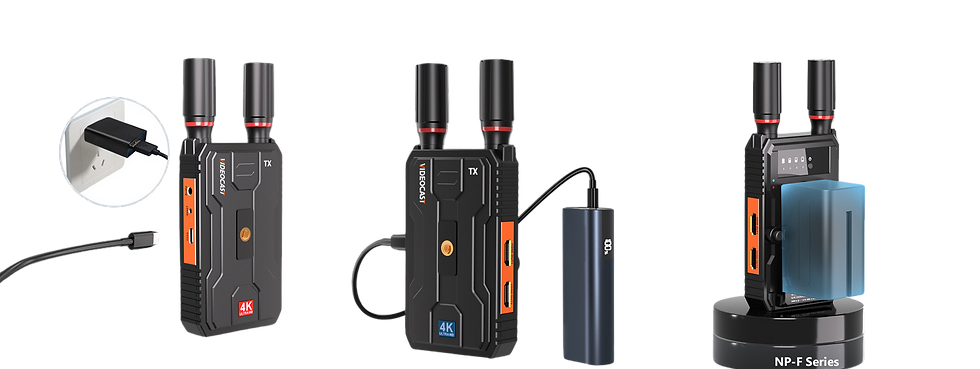Unlocking Seamless Connectivity: A Comprehensive Guide to Video Receivers and Transmitters
- Videocast

- Sep 23
- 4 min read
In today’s fast-paced digital world, seamless connectivity is more vital than ever. Whether you are a professional in the broadcasting industry or a tech savvy enthusiast, understanding the intricacies of video receivers and transmitters can elevate your audio-visual experiences. Imagine enjoying crystal-clear broadcasts and smooth streaming without the dreaded lag or signal loss. the latest technologies to practical setup tips, you’ll gain the insights necessary to enhance your connectivity. Say goodbye to cumbersome cables and hello to a world of wireless freedom as we navigate the essentials of video transmission.

How Video Receivers and Transmitters Work
Understanding the fundamental workings of video receivers and transmitters is essential for appreciating their value in modern connectivity. At the core, Wireless video transmitters are devices designed to send video signals from a source, such as a camera or computer, to a receiver, which then displays the video on a screen. This process involves converting video data into a signal that can be transmitted over various mediums like radio waves, cables, or even the internet. The receiver’s job is to decode this signal back into video data that can be viewed.
Key Features to Look for in Video Receivers
High-definition (HD) and 4K resolutions are now standard in many applications, so it’s important to choose a receiver that can handle the resolution of your video source to maintain image quality.
1. Signal Compatibility
Look for receivers that support multiple input and output formats such as HDMI, SDI, and IP streams. This ensures flexibility when connecting to cameras, switchers, monitors, and encoders.
2. High-Resolution Support
Ensure the receiver supports Full HD (1080p) and 4K resolutions for sharp, professional-quality visuals. For future-proofing, 4K HDR compatibility is an added advantage.
3. Low Latency
Low latency is critical for live streaming, sports broadcasting, or interactive events. A receiver with ultra-low delay helps keep audio and video perfectly synchronized.
4. Audio Integration
Check for embedded audio support along with balanced/unbalanced audio outputs. Some receivers also provide audio de-embedding, which can be useful for routing sound separately.
5. Power Options
Flexible power supply options, such as PoE (Power over Ethernet) or DC input, add convenience, especially in outdoor or mobile environments.
6. Future-Proofing
Choose a receiver that supports firmware updates. This ensures you can add new protocols and features as technology evolves.

Types of Video Transmitters: A Breakdown
Video transmitters come in various types, each designed for specific applications and environments. One common type is the HDMI transmitter, which is widely used in home entertainment systems, gaming setups, and professional AV installations. HDMI transmitters send high-definition video and audio signals over short distances, typically within a single room. They are known for their ease of use and compatibility with a wide range of consumer electronics.
Benefits of Using Video Receivers and Transmitters
The use of videocast video receivers and transmitters offers numerous benefits, making them indispensable in today’s digital landscape. One of the primary advantages is the elimination of cumbersome and restrictive cables. Wireless video transmission allows for greater flexibility and mobility, whether you’re setting up a home theater, conducting a live broadcast, or filming on location. This freedom from cables simplifies installation and reduces clutter, creating a cleaner and more efficient setup.
Common Applications for Video Connectivity Solutions
Video connectivity solutions are used in a wide range of applications, each benefiting from the unique advantages of video receivers and transmitters. In the broadcasting industry, these devices are essential for live television production, enabling the seamless transmission of video from cameras to control rooms, and then to viewers' screens. This ensures high-quality, real-time broadcasts without delays or signal degradation, which is critical for news, sports, and live events.
Comparing Wired vs. Wireless Video Transmission

Troubleshooting Common Issues with Video Receivers and Transmitters
Despite their advanced technology, HDMI Wireless video transmitter can sometimes encounter issues that affect performance. One common problem is signal interference, which can result in a degraded video quality or complete signal loss. Interference can be caused by various factors, including other wireless devices, physical obstructions, and electromagnetic interference from electronic equipment. To mitigate this, ensure that your transmitter and receiver are positioned to minimize obstructions and are operating on a clear frequency channel.
Future Trends in Video Connectivity Technology
The future of video connectivity technology is poised to bring even more advancements and innovations, enhancing the way we transmit and receive video signals. One significant trend is the increasing adoption of 5G technology, which promises to revolutionize wireless video transmission. With its ultra-fast speeds, low latency, and high capacity, 5G will enable real-time video streaming and remote production, opening up new possibilities for broadcasting, live events, and virtual reality applications.
Conclusion:
Selecting the right Wireless transmitter for your needs involves considering several factors, including the specific requirements of your application, the environment in which you’ll be operating, and the desired level of performance. Begin by assessing the resolution and quality of the video you need to transmit, ensuring that the devices you choose support the necessary standards, such as HD, 4K, or higher. Compatibility with your existing equipment, such as cameras, displays, and other AV devices, is also crucial.
Contact Us:
Email: info@videocast.solutions
Phone: +91-9210025777
Website: www.videocast.in



Comments